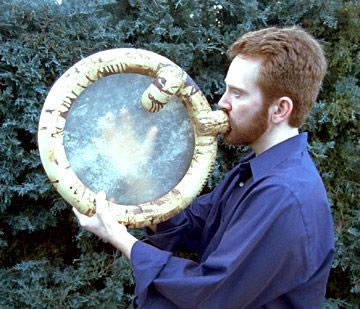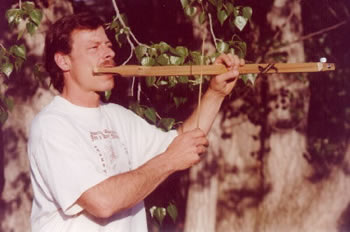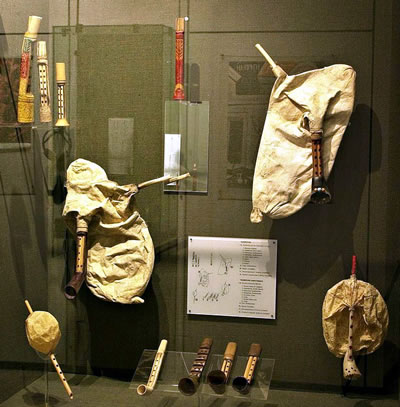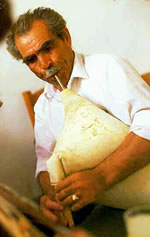http://www.google.com.gr/search?hl=el&lr=&ie=UTF-8&oe=UTF-8&q=kroupez&sa=N&tab=iw
Egy hangszerlista, talan hasznos lehetne a Kabocaba..., sajnos a kepeket nem tudtam atvenni.
DICTIONARY OF INSTRUMENTS
askros: a kind of krotala, clappers or castenets considered by some to be the same as
or similar to another percussion instrument: the psithyra.
askaules: bagpipe. The word appears in Roman times used by Martial.
aulos: principal and most important wind instrument, played alone or combined with the
voice or with stringed instruments, especially with the kithara. [See above.]
Usually the aulos was used in pairs; the two auloi were called "twin auloi", also
"double pipe". Each had its own mouthpiece. Sometimes the pipes of the two
auloi were of equal length; sometimes one was longer than the other. Each aulos
had a number of lateral finger holes called trčmata or trypčmata. The reed,
made of cane, was called the glottis, glossis, or glossa. Due to the force
required to blow the aulos, the auletai, as shown in vase-paintings, wore a
feather band called the phorbeia or epistomis (in Latin: capistrum).
Other names given to the aulos are:
diopos: having two holes
hemiopos: having half the number of holes
hypotretos: pierced from below
kalliboas: with fine tone
mesokopos: of middle size
paratretos: pierced sideways
polytretos: having many holes
polykampes: much-twisted
polykompos: loud-sounding, sonorous
polymekes: of great length
polymeles and polymelpes: many-toned, capable of many melodies
polyphthongos and polyphonos: many tones, sounds
barybromos: with deep, strong sound
barbitos, barbiton: a variety of the lyra but narrower and longer; consequently its
strings were longer and its pitch lower. Other names are barmos, baromos and
barymiton, the latter two mentioned by Sappho and Anacreon.
calamos: the aulos made of the "calamus" reed.
canon: usually surnamed "the Pythagorean canon" because of its invention was
atrributed to Pythagorus. It is a monochord used to determine the mathematical
relationships of musical sounds. The canon is often taken for the monochord.
chelys: primitive lyra, so-called because its soundbox was made from a tortoise shell.
cymbala: two hollow, hemispherical metal plates of Asiatic origin, first used in the
orgiastic cults of Cybele and later of Dionysos. Another word for cymbala is
bakyllion or baboulion. Cymbalion, dimunitive of cymbalon, means a small
cymbal. [See above left.]
discos: metal disk or gong with a hole in the middle, suspended by a cord and struck
with a hammer.
dizygoi, dizyges auloi: double aulos; twin-auloi.
echeion: mystical name for the cymbal in the cult of Demeter. Also echeia, or
hemispheric vases of different sizes producing different sounds when played with
a small stick. The word echeion means the sound-plate or sound-box of stringed
instruments.
elymos: kind of Phrygian aulos with two pipes of unequal length, of which the longer on
the left was curved and bell-shaped, probably due to the insertion of a type of
horn.
embaterios aulos: aulos playing the embaterion melos or marching songs during a
military march.
emphysomena: wind instruments in general. The word is derived from physan (= "to
blow").
enchorda, organa: stringed instruments in general which can be divided into the
following families:
a) lyra and kithara family: phorminx, kitharis and barbitos.
b) psalterion family: magadis, pektis, sambyke, phoenix or phoenikon or
lyro-phoenix, epigoneion, simikon and trigonon.
c) lute family: trichordon, pandoura.
Aristoxenus names as "foreign instruments" the phoenix, pektis, magadis, sambyke,
trigonon, klepsiambos, skindapsos and enneachordon.
epigoneion: a stringed instrument of the psalterion family, played by the fingers without
the aid of plectrum. Its etymology derives from epi (= "on or upon") and gony (=
"knee"). According to the testimony of Pollux, the epigoneion had 40 strings and
was one of the largest polychord instruments used in ancient Greece.
epistomis: see phorbeia.
gingras: a small aulos of Phoenician origin with a piercing tone and of a lamenting and
mournful character. Also, the name of Adonis in the Phoenician language.
helicon: stringed instrument similar to the canon and monochord used to measure the
consonances. In a figurative sense, the word comes from Helicon, "the mount of
the Muses". A diagram showing the proportions of the helicon has been handed
down to us by Ptolemaeus.
hendakachordon: type of lyre with eleven strings and ten intervals, according to the
testimony of Ion of Chios. The eleventh string was added by Thimotheus of
Miletus.
heptagonon: unknown instrument of septangular dimensions referred to by Aristotle in
his "Politics".
hydraulis, hydraulos, hydraulikon organon: derives from "water" and "aulos". An
organ in which the sound is produced by hydraulic air compression and the
invention of which has been attributed to Ctesibius, a Greek mechanic and
barber of Alexandria. Some scholars have accredited Archimedes with the
invention of the hydraulos, the principle of which is based on the syrinx
polycalamus or "Pan pipe".
iambyke: a stringed instrument of triangular form, so-called because it accompanied the
songs [called] iamboi, as mentioned by Phyllis of Delos and Hesychius.
kindapsos, skindapsos: a big, four-stringed instrument of a lyroid form, played with a
feather plectrum.
keras: a kind of trumpet made of horn.
kithara: a more perfect and elaborate stringed instrument than the lyra. It differs from
the lyra in its soundbox, size and sonority. The soundbox is wooden and much
larger than that of the lyra, thus producing a sound more sonorous and fuller. The
classic form of the kithara has seven strings. While the lyra remained an
instrument restricted to amateur players, the kithara was largely used by
professionals and was termed by Aristotle organon technikon (i.e., a "profes-sional
instrument"). [See above, preceding page.]
kitharis: a primitive stringed instrument identified with the lyra or phorminx, while other
historians identify it with the kithara. Its sound-box is wooden and resembles the
round shape of the tortoise-shell. Vase representations of the kitharis recall
posterior instruments of the Middle Ages, such as the crwth or rotta.
klepsiambos: unknown instrument with nine strings used to accompany declamations,
"parakataloge". Belongs to the psalterion family.
krotala: castanets or clappers: a percussion instrument consisting of two hollow pieces
of shell, wood or metal which when clapped together produce a sound called
rhymbos or rombos.
kroupezion: wooden shoe or sandal used to mark the time in dancing; usually a small
piece of metal was attached to the sole to make the beating clearer and stronger.
The term podopsophos was used for the man beating the time with his foot.
lyra: the most important and most widely known of all instruments of ancient Greece
[see above]; associated with the cult of Apollo [as was the kithara]. The funda-mental
parts of the lyra are:
• The sound-box, echeion, made of the carapace of the tortoise, poetically
called the chelys (from chelone - "tortoise"). Over its opening, a vibrating
membrane of hide stretched.
• Two arms made of horn or wood, called peichis (= "arms") or kerata (=
"horns"), projected above the sound-box. These arms were joined by a
crossbar made of wood and called zygon or zygos (= "yoke").
• Its strings, made of gut or linen and called chordai or neurai, were
attached to the chordotonion or chordotonos, which was made of wood
and situated in the lower part of the sound-box. The strings passed over a
bridge called magas and stretched to reach the zygon, where they were
fixed by mobile leather or cotton rings or pegs called kollaboi and
kollopes.
The primitive lyra had three strings. The type most frequently represented in vase-paintings
had seven strings. An eighth string, supposedly added by Pythagorus,
appeared in the 6th century B.C. The addition of a 9th string was attributed to
Theophrastus of Piera; a 10th string, to Histaeus of Colophon; and an 11th string,
to Thimotheus. Other sources attribute the addition of a 12th strung to
Melanippides.
magadis: a stringed instrument of the psalterion family. The origin of the magadis,
according to Anacreon, was Lydian. It consisted of twenty strings, probably tuned
in pairs (each of the pair sounding the octave of the other). The term magadizen
implies "to sing or play in octaves". Magadis also refers to a Lydian aulos.
monaulos: a single aulos or a single-piped aulos; also called calamaules.
monochordon: as its name implies, an instrument with one string. Like the canon, the
monochordon was employed to determine the mathematical relationships of
musical sounds.
nablas, nabla: a twelve-stringed instrument of the psalterion family, of Phoenician origin
[and thus related to the Hebrew nevel], and played with the bare fingers, without
a plectrum or plectron.
niglaros, ginglaros: small aulos of Egyptian origin, played to mark the regulated move-ments
of the rowers.
organon: generic name for stringed and wind instruments.
pandoura, pandouris, pandouros: a three-stringed instrument of the lute family, also
called tricordon. Pandourion is the diminutive form of pandoura.
parthenios aulos: the highest-pitched aulos or "virginal" aulos.
pektis: a stringed instrument closely associated with the magadis.
pelex: a stringed instrument of the psalterion family mentioned by Pollux. Nothing else is
known about it.
phoenix: a stringed instrument similar to the magadis and the pektis.
phorbeia: also called peristomion and epistomis; in Latin = capistrum. It consists of a
leather band similar to a muzzle, which the aulos player or auletai used around
his mouth and cheeks. It had a hole in front of the mouth to allow blowing into the
aulos, and it was tied behind the head. Use of the phorbeia allowed the player to
blow the aulos for a long, continuous time without tiring his face and cheek
muscles.
phorminx: primitive lyra; probably the most ancient stringed instrument played by the
epic-singers called aoedoi. It had two arms made of horn. Homer referred to it as
perikalles (= "very beautiful"). [See above.]
photinx: wooden transverse aulos, of Egyptian origin, similar to the plagiaulos.
physallis: a kind of aulos; from the word physan (= "to blow"). The name is mentioned
by Aristophanes and Lysistratos.
plagiaulos: a transverse aulos which, according to Pollux, was of Lybian origin and
made of lotus wood. It was characterized by the use of a fine membrane that
covered one hole, thus producing a sound similar to that produced by the reed of
a normal aulos. Its special tone color is recalled by the modern "mirliton" or
"eunnuca flute". [Included in the set of auloi above.]
psalterion: a generic term for stringed instruments played directly by the fingers without
the use of a plectrum. However, the word psalterion was used in the sense of a
specific instrument. Latin: psalterium. From the verb psallein (= "to touch with
the fingers").
psaltinx: a kind of kithara.
pteron: an unknown instrument; probably a wind instrument because it is usually asso-ciated
in Greek literature with the auloi and the hydraulos. Literally means "wing".
pythikon: an unknown stringed instrument also called dactylikon.
roptron: a small and light drum consisting of a wooden hoop with a piece of parchment
stretched over it and small pieces of metal fastened around it: a tambourine.
salpinx: straight trumpet made of metal or bone. The horn trumpet was called keras =
horn. The shell trumpet was called triton in honor of Triton, son of Neptune [i.e.,.
Poisedon] and his trumpeter.
sambyke: a stringed instrument in the form of a small harp whose name is derived from
a ship and which was introduced into Greece from Syria and Egypt. The instru-ment
retains the same name because its shape recalls the image of a sambyke
(= "boat"). [See above.]
seistron: from the word seio (= "to shake"). In Latin: sistrum. A small percussion instru-ment
in the shape of a stirrup or horseshoe, with a handle and loose crossbars
lined with tiny metal discs. It came from Egypt, where it was used in cult
ceremonies in honor of Isis. Aristotle relates that along the river Escamandros
grew a certain type of plant named sistro or seistros, supposedly belonging to
the chickpea species, whose seeds when dry produced soft-sounding noises
when shaken, and which were believed to frighten off evil spirits. [See above, top
right.]
simikion: a stringed instrument of the psalterion family with 35 strings, like the epigo-neion.
skytalion: a small stick; term for a very small aulos. The elymos or Phyrgian aulos was
surnamed skytalias.
spadix: a stringed instrument like the lyra, mentioned gy Nicomachus. It is also a branch
of the palm tree with its fruits or dates.
syrinx: Pan pipe or shepherd's pipe.
tityros, tityrinos aulos: a shepherd's aulos made of reed or cane.
trichordon: a three-stringed instrument, also called pandoura. It was perhaps the only
instrument with a neck used by the Greeks; of the lute family.
trigonon, trigonos: a stringed instrument of triangular form, as its name indicates. It
was actually a harp and was played by the fingers or with a plectrum, and it had
various strings of different lengths. It belonged to the class of "polychord" (many-stringed)
instruments.
tympanon: a percussive instrument in the form of a cylindrical box, with skin mem-branes
stretched over both ends; it was played with the hand and usually by
women during the rites of Cybele and Dionysos. A kind of tambour or hand-drum.
[See above.]
Tyrrhenos aulos: an Etruscan aulos.
xylophonon: from xylon = "wood", and phone = "sound". The word xylophonon was
unknown in ancient Greece and the use of the "xylophone" is not certain.
However, an instrument in the form of a small ladder appears on various Apulian
vases. It could well have been a kind of sistrum or seistron.
=== === ===



 http://www2.szepmuveszeti.hu/kopt/glossary.php?s=Sistrum
http://www2.szepmuveszeti.hu/kopt/glossary.php?s=Sistrum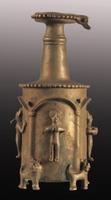 http://www2.szepmuveszeti.hu/kopt/targy.php?id=381
http://www2.szepmuveszeti.hu/kopt/targy.php?id=381





